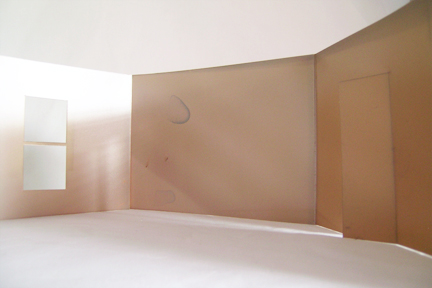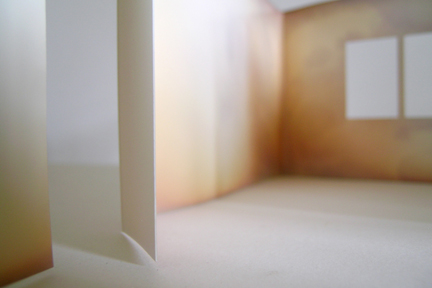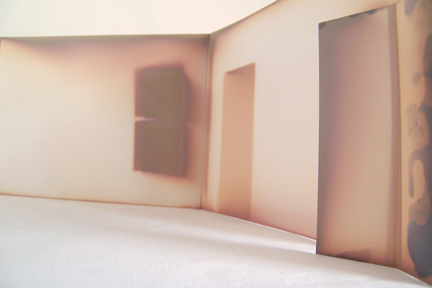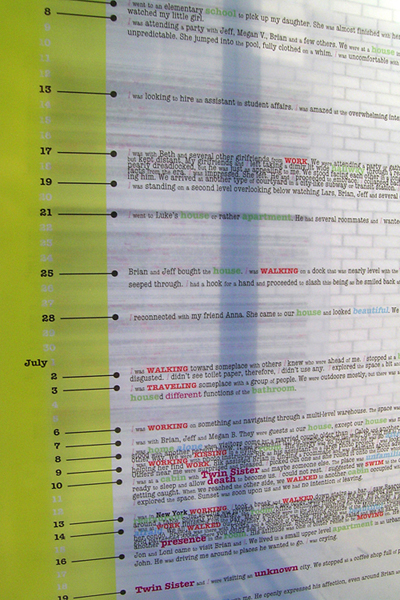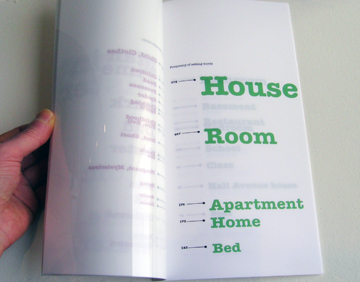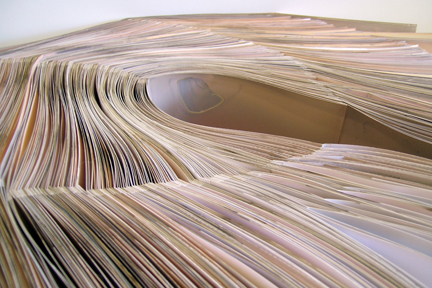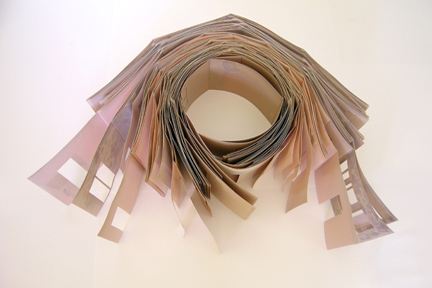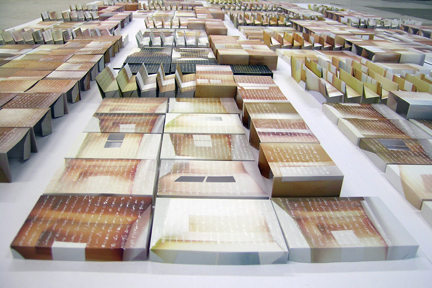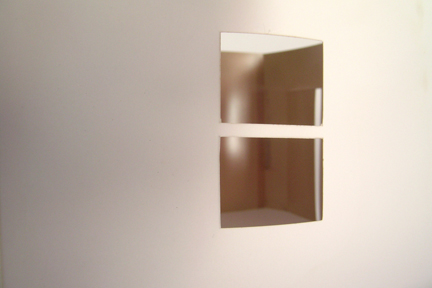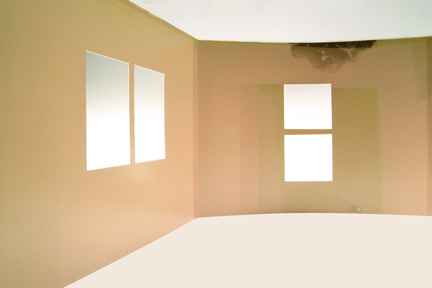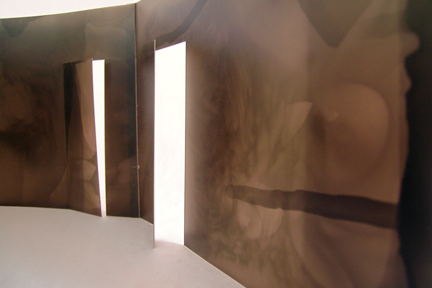The Return
Based on a night-time dream on 9 June 2010, my essay The Return weaves lived facts with imagination. It thematically brings together key aspects of my current research: memory, domestic space, light, shadow, transformation, and sensory contact. The essay is an example of an experimental approach to an autobiographical narrative where domestic space is an important feature. It also serves as a metaphoric summary of my methodology of exploring the sensitivity of the photogram as a medium to record the blurred divisions between memory, representation, and the present. A photogram is an image made by exposing chemically-treated paper to light, without the use of an analogue camera. While the process can be traced to the origins of photography as scientific renderings of nature, the presentation of my photograms as three-dimensional models of domestic space and as abstractions of reality places the work in a new context. My research is informed by Vilhem Hammershøi's paintings of 'the empty interior,' Uta Barth's photographs, which direct our attention to the activity of seeing, László Moholy-Nagy's innovate use of the photogram, Carl Jung's concept of 'house' as a metaphor of 'self,' and Anaïs Nin's diaries, which connect together dream and descriptive accounts of lived experience. Respectively, each is a significant contribution to unconventional approaches to both image-making and self-referential investigations.
The concept of my project resides in the notion that home is a specific form of experience whereby the autobiographical story can take centre stage. Throughout this exposition, home, domestic space, and the domestic interior are used interchangeably and are defined as a reflective space. As with identity and memory, home is not necessarily a fixed location, but an ongoing process of invention. [1] Heidegger’s concept of home and homelessness resides in thought and imagination. He claimed that we can never be ‘at home’ since thought is nomadic and has no fixed boundaries; thought itself is the estrangement from home. Heidegger’s perspective destabilises perceptions of home as a separate and ideal space and establishes home as being inseparable from being itself. [2] Therefore, home can be differentiated from the stable structure of a house in that home facilitates a narration of identity, memory, and aspirations. Home is an internalised process, made meaningful through reflecting upon what it is, what it was, and what it is to become.
[1] See also, Irene Cieraad, 'Homes from Home: Memories and Projections', Home Cultures, 7.1 (2010), pp. 85–102.
[2] Martin Heidegger, ‘Building Dwelling Thinking’, in Poetry, Language, Thought, trans. by Albert Hofstadter (New York: Harper & Row, 1971), pp. 143–61 (p. 161).
A recognition of the significance of ordinary nuances trigger the poetics of memory. My project, in part, is about the familiar quest – a quest situated somewhere in between the known and the unknown.
Self/Discovery
I assumed the solidity of the decades-old four-storey brick apartment building and the interior that framed my living space to be a safe enclosure and that my accumulated possessions stored within would always be available. However, just minutes before midnight on 31 December 1994, a fire started in my apartment. Moments later, I lost everything I owned – from the present to my childhood memorabilia. My possessions consisted of the clothing I was wearing. The consequence of losing every acquired material possession was a paradigm shift in my life and a reminder that memory is an act of creation. Following this event, one of the first things I purchased was a pocket-sized notebook and a pen in an effort to reclaim my past by writing what I could remember of the things I had lost. Nearly two decades later and living in another country, I have again experienced a radical loss of home. The geographical distance between my impermanent homes has been an asset to my research in discovering a method of recreating home, as a diary, from memory.
My research employs a heuristic method of investigation. I rely on a synergy between making photograms and paper sculptures to record my memories that emerge from my depictions of personally experienced domestic spaces. In doing so, I avoid assigning value or judgement and give each memory equal voice and space. Clark Moustakas and Michael Polanyi [3] have been influential in examining personal knowledge as a research method aimed at finding the underlying meanings of shared human experience. Critical self-reflection is inherent in this technique, as is an authentic attempt to discover and develop methods to explicate further the value of personal accounts. The impetus behind my investigation into the relationship between autobiography and domestic space has been a close observation of the rooms I have inhabited throughout the course of my own migration, living in twenty residences in various cities, across two countries. My observations range from ordinary activities to architectural features to emotional or insignificant accounts with others to life-changing events. My focus is not on lost possessions, but on rooms as spaces of memory. My personal migration is by no means a unique experience. Moving house and the loss that one incurs underlie my enquiry into a creative visualisation of home.
As my research progressed, I broadened the scope beyond my personally inhabited rooms to include all the bedrooms, kitchens, and living rooms that I have spent time in, such as in the homes of family, friends, and neighbours, resulting in a recovery of hundreds of memories. This comprehensive survey substantiates my concept that rooms, regardless of being personally lived in, offer a rich contribution to autobiography – visually and textually – rooted in domestic space. Rather than suggesting a conclusive outcome, the validity of my research lies in the elusive persistence of memory as an act of becoming, as discovered in photograms and the making of paper sculptures.
[3] Clark Moustakas, Heuristic Research: Design, Methodology, and Applications (Thousand Oaks, CA: Sage, 1990). Clark Moustakas, 'Heuristic Research', in Challenges of Humanistic Psychology, ed. by J. F. T. Bugental (New York: McGraw-Hill, 1967), pp. 101–7. Clark Moustakas, Individuality and Encounter: A Brief Journey into Loneliness and Sensitivity Groups (Cambridge, MA: Doyle, 1968). Michael Polanyi, Personal Knowledge: Towards a Post-Critical Philosophy (Chicago: University of Chicago Press, 1962). Michael Polanyi, The Tacit Dimension (Garden City, NY: Doubleday, 1966). Michael Polanyi, Knowing and Being, ed. by Marjorie Grene (Chicago: University of Chicago Press, 1969).
Re-direct Contact
I unintentionally bought several unused boxes of aging photographic paper at an antique centre. While standing outside on a winter afternoon, I opened one box and pulled from the protective black plastic envelope one sheet of white paper. I was mesmerised as I watched the instant transformation of the white paper turn to a shade of purple. I immediately saw the potential of this chemically-reactive medium to both trigger and represent memories. I began my exploration by focusing on the bedroom as it is the space where the self is most intimately experienced. In an effort to re-envision these spaces, I constructed abstract versions of these rooms by adhering together four sheets of the light-sensitive paper for the walls and cutting out the placements of windows, doors, and closets where I remembered them to be. I layered the paper rooms on top of one another and exposed them to natural light. Casts of the cut-out windows, doors, and walls were projected onto the next room in the sequence and established my conceptual direction: namely, memories appear as impressions, recall is spontaneous, and the past is constantly being created in the present. During this process, dormant memories emerged. (I typed 17,900 words of memories that took place within each of the twenty bedrooms I have inhabited throughout the course of my life.) When I fixed these images in the darkroom, an additional experimental process happened when the chemicals interacted with the paper; new ghostly marks appeared. Once fixed, these four-page room reconstructions served as the models I then digitally photographed from various cropped views, also under natural light conditions, to create intimate bed-like paper sculptures. Embracing the traditional method of diary keeping, I hand-wrote my memories onto the paper sculptures using a calligraphic pen. I used white ink as it compromises the clarity of legibility and encourages a public viewing audience to spend time with the sculptures and to consider their own relationship with memory and domestic space. Inherent in the technique, each photogram and corresponding paper sculpture is unique and carries with it a particular memory. Collectively, the photogram rooms and simplified furniture paper sculptures form a domestic diary from my earliest memory to the present.
This experimental process has been the foundation of my practice and has enabled me to retrieve and visually articulate memory and domestic space through the combination of chance, utilising both analogue and digital technology and engaging with paper. The unique capability of the photogram is its reliance on light to touch the surface of the paper, which results in an image that reacquaints us with the subtle dimensions of memory and the present. The photogram models encourage a visualisation into the miniaturised spaces, thus initiating a different image of what a room is and how it is experienced.
A House of Dreams
The creative potential of memory and dreams in relation to dwelling has been explored by Swiss psychoanalyst Carl Jung, who devoted much of his philosophy to dream analysis and the metaphor of the house as an extension of the self. It is worth noting that the impetus for exploring the architectural metaphor of the psyche springs from a dream Jung had in 1909. In the dream, he traverses a multi-storey house where on the various levels he observes present, historical, and prehistorical artefacts. He likened these levels to passages to consciousness (upper level), personal unconsciousness (ground level), and collective unconsciousness (below ground level). [7] These hierarchical metaphors are intuitively grasped and contain within them the potential for showing how the concept of home as an autobiography can be examined spatially and through a process suggestive of layering.
Jung has been influential in the analysis of consciousness and the unconscious. His psychological theories were directly informed by studying his own psychological processes: through dreams, journal writing, painting, carving stone, and building a house. Jung approached dreams as living realities that should be observed as informative experiences – a concept that has informed much of my understanding and creative practice. Dream and memory share similar qualities in that they can be experienced with intense emotion, appear suddenly, and can lead to insightful discoveries. The opening sentence in the prologue to Jung's autobiography, Memories, Dreams, Reflections, succinctly summarises his view, 'My life is a story of the self-realisation of the unconscious.' [8] Inspired by his journey through the dream house, over a twelve-year period at Bollingen in Switzerland Jung built a primitive stone dwelling called the Tower in an effort to delve deeper into the metaphor of the house as an extension of the self. Built in successive additions, the Tower reflects the stages of Jung's self as he was becoming. It also materialises his dream house and creates a diagram of the self in structural form. It is appropriate to consider the permanence of the material he used to construct these elusive qualities spatially. Whereas Jung was deeply connected to the permanence of stone as a solid representation of his psyche, my paper rooms refer to the fragility of shaping intangible qualities into form. They emphasise memory as a fragile ‘place’ and in their documented form also validate perhaps otherwise insignificant occurrences. What can be learned from Jung, among other things, is the need both to recognise the importance of the dream metaphor and to manifest its message in material forms of communication, such as in architecture, image making, and the written-word.
The process of making photograms mimics the elusive nature of memory, time, and perception. Its mysterious quality creates a reflective and inconclusive atmospheric image. The abstract nature of the photogram liberates fixed interpretation thus allowing assumptions of representation to be reconsidered. Cultural historian John Berger shares a similar view for an alternative use of photography as a medium of memory. Berger has extensively investigated the role image and reproduction plays in directing how we as a culture 'see' and reminds us that 'images were first made to conjure up the appearances of something that was absent'. [4] The use of the word 'appearances' and 'absent' aptly describes the process of translating memory onto a light-sensitive surface. Once fixed, these impressions serve as an aid to tactile memory of space felt through the warmth of light or coolness of shadow. Take, for example, how the traditional representational photograph of an event becomes the memory. Therefore, the details outside the framed image are lost or forgotten. It is in what is not captured by the camera that my interest in photographic representation lies.
My practice refers back to what László Moholy-Nagy discovered in the photogram: that they made visible new relationships of space, form, and light. According to Moholy-Nagy, the essence of photography is not the camera, but the chemical sensitivity of film and paper, which documents the print of light. [5] Moholy-Nagy is notable for having described the photogram as 'painting with light'. This concept can also be translated as drawing memory on a surface. The photogram, in essence, is a record of a temporal event. Moholy-Nagy’s first photograms in 1922 were compositions of translucent pieces of paper cut into geometrical shapes and small common objects that were gradually developed in the sunlight, a process I have applied to my 'rooms'. Not only was the image the result of an interaction between the light and the object, it also had a tactile quality arising from the physical contact between the object and photographic paper. These experimental image-making processes introduce an alternative method of recording memory through the sensitivity of touch.
I identify with Jung’s idealism and life-long quest to merge the known with the unknown. He brings forth a presence with an in-between place, where opposites, such as dream and waking reality, material and immaterial, join and are experienced as one. I align my personal practice of documenting memories and (dreams) with Jung's conclusion that dreams provide a valuable insight into our embodied realities. For example, in 2009 I completed a project titled I Remember Dreaming, a catalogue of my dreams from 1995–2008 in the form of large-format banners printed on transparent paper. During the process of transcribing my thirteen-year collection of dream entries contained in forty-four notebooks, I highlighted significant keywords which informed my waking memories. In a thematic analysis of my dreams, I organised the keywords into five categories – symbol, setting, feeling, action, and geographic location – in an effort to quantify the emerging patterns. Pertinent to my current research, I identified the number of times domestic settings were recorded. House was written 776 times, room 467 times, apartment 176 times, and home 170 times. The quantity and repetition of these domestic dream locations relates to my personal migration and has prompted a continued examination into the significance of home (either in dream or conscious experience) as an autobiographical space. Often subliminal, domestic spaces co-create our identities through repetition, thought, emotion, and action. What binds home and identity together is pattern. My practice reflects this union of pattern making. The photogram rooms and furniture paper sculptures are an incomplete story when viewed individually. The accumulation of these sculptural spaces and hand-written narratives provide substance to an investigation of memory.
[7] C. G. Jung and Aniela Jaffé, Memories, Dreams, Reflections, trans. by Richard and Clara Winston (London: Collins, 1963; repr. Fontana Press, 1995), p. 184.
[8] Ibid., p. 17.
Home is a sort of photogram. The interior and exterior are constantly subject to light and shadow which expose and conceal surfaces.
Implicit in their creation, my photogram rooms are intimate and to be encountered like a book – touched and exposed to a natural process of wear through use and age. Touch, denigration, and transformation expose the aging process, which is vital to identity, autobiography, and memory. Without touch, substance and the ability to perceive space are compromised. Fundamentally, the photograms are designed to be interacted with – to elicit memory and to invoke an altered perception of real and imagined space. Guided by the concept that embodiment is what constitutes remembered happenings, [6] the haptic experience is necessary to image-making and meaning. The making of my photogram rooms requires the steadiness of my hand, the patience of natural light to touch the surface of the paper, dipping the image in fixer, and placing the paper on the racks to dry. Making images reliant on the transient qualities of light is speculative, entailing both spontaneity and reflection. In other words, my process records memory as an act of creation. Of interest is how the photogram can be constructed as a three-dimensional artefact to be interacted with and viewed from various points of contact that redirect the narrative of memory as a present and physical occurrence in a similar manner to the experience of home.
[4] John Berger, Ways of Seeing (London: Penguin, 1972; repr. 1990), p. 3.
[5] László Moholy-Nagy, Painting, Photography, Film, trans. by Janet Seligman (originally published as Malerei, Fotografie, Film, 1927; London: Lund Humphries, 1969), p. 32.
[6] Edward S. Casey, Remembering: A Phenomenological Study, 2nd edn (Bloomington: Indiana University Press, 2000).
The Diary
The effort to document internal experiences is not only a pursuit in self-awareness but also a quest to connect with something greater than oneself. The diary, as an image of a notebook with a lock and key, propagates a truth-seeking and private endeavour. At the same time, as an object it exists externally and carries with it the potential for shared reading, whether intentionally, accidentally, or posthumously. As with carefully crafted autobiographies, the diary, as an account of life as it is happening, enriches understanding of the human condition. It is in this potential that my enquiry seeks to include the practice of life documentation manifested as an artefact that broadens the scope of traditional autobiographical representation.
Complimentary to Jung's laboured commitment to building the Tower, he also embarked on a sixteen-year private self-experimentation journey in his diaries known as The Black Books. Jung's diaries are organised like a medieval illuminated manuscript with calligraphic writing and colourful paintings. The Black Books are not conventional diaries of events, but rather records detailing his unconscious fantasies as they arose. [9] From these, The Red Book (Liber Novus) published posthumously in 2009 was conceived. The Red Book is a transcription and an elaboration of The Black Books with added commentary for the public reader in mind. There is an innate need for self-realisation, which leads people to explore both inwardly and outwardly. This natural process, in Jung's terms, is individuation or the process of becoming an individual. The result of self-experimentation, The Red Book presents a prototype of Jung's conception of the individuation process [10] – a transcendence of oppositions within the personality – central to his psychological philosophy. The Red Book is an exemplary example of an unconventional form of autobiography that explores the blurred divisions between dream, imagination, memory, analysis, and theory. Likewise, the Tower may be regarded as a three-dimensional continuation of his diaries. [11] The diary and a self-built home represent a desire to manifest internal experiences and connect them to the collective one; at the same time, they entail vulnerability and necessitate a risk in self-disclosure. Creative visualisation of the individual experience, particularly within the intimacy of domestic space, is a pursuit worth examining as a method of storytelling.
[9] C. G. Jung and Sonu Shamdasani, The Red Book = Liber novus, trans. by Mark Kyburz, John Peck, and Sonu Shamdasani, Philemon Series (New York: W. W. Norton, 2009), pp. 199–200.
[10] Ibid., p.207.
[11] Ibid., p. 216.
[12] Sharon Spencer, Collage of Dreams: The Writings of Anaïs Nin (Chicago: Swallow Press, 1977), p. 50.
[13] Anaïs Nin, The Diary of Anaïs Nin. Volume One, 1931–1934, ed. by Gunther Stuhlmann (New York: Swallow Press / Harcourt Brace Jovanovich, 1966), p. 331.
[14] Suzanne Nalbantian, Aesthetic Autobiography: From Life to Art in Marcel Proust, James Joyce, Virginia Woolf and Anaïs Nin (Basingstoke: Macmillan, 1994), p. 179.
[15] Spencer, p. 146.
The Paper Room
In the late afternoon, sunlight enters my living room window and casts its refracted glow on the wall, painting an image of my open blinds and the out-of-focus movement from the leaves of the tree nearby. The temporal decoration grounds me to the space I co-occupy in real time with my surroundings. Aware of a moment that will not replicate itself, I am then moved to take a photograph of a photogram model I have constructed of the kitchen in the house where I lived from birth to infancy as to allow the light to work its magic on another sort of ‘wall’.
How might the interplay between a real room and a miniature, constructed room provide a continuity between the real and the imagined, between physicality and the memory of physicality?
Exploring memory encompasses a vast supply of impressions that allow me to penetrate through routine representations to 'see' the evolving self. Remembrance always begins with where I am in the present, but I soon discover that the beginning can start anywhere; it is fallible and takes me on a meandering path rich with fleeting scenes that I try and harmonise with my current sense of self – which for my argument is a self rooted in domestic space.
Before a house is built, it is visualised on paper. The earliest childhood 'drawing' I can remember, from when I was five years old, was of my house and was made with torn pieces of coloured construction paper. I didn't make this collage drawing from direct observation, but rather through visualising my house as I saw it. Drawing with paper allowed me to move through my memory. My practice is significantly informed by the material and spatial potentialities of paper. Whether through direct or indirect touch, contact with paper has value in its physical presence. It is tactile, familiar, malleable, portable, and fragile. At the same time, it is durable and reliable. Paper appropriately links memory and the sensory experience with home. Both paper and home share similar and yet opposing characteristics. Each are subject to aging, wear, and neglect, or even devastation. Embracing these dualities can help shape our material connection to the physical world. For example, wabi-sabi, the Japanese concept of aesthetics, underscores that authenticity is found in imperfection, aged material, and decay; as such, it reminds us of the transient nature of all things. In the creation of meaning, home and paper can establish a cohesion from layers of perhaps disconnected or non-linear sequences of a life unfolding. My photograms and paper sculptures are not necessarily designed to endure the unpredictable conditions of time, but rather they document a process of recollection. The slow and labour-oriented process of traditional techniques of the photogram is reflective and congruent with my research focus on the visceral and spatial qualities of memory, as opposed to the rapid image capture of digital photography, where in many cases the image never materialises in print and is taken not necessarily to be saved but rather to be quickly shared, deleted, or otherwise disregarded. In this context, my practice is a response to the superficial photograph as a means of representation.
Influenced by Jung, French-Cuban author Anaïs Nin was a significant contributor to an experimental autobiographical investigation. Living through the Second World War and between various international cities, Nin had no particular place to identify as home. This sense of 'homelessness' parallels my personal experience, which identifies home as a transitory space, albeit a repository for memory. For Nin, the notion of home was integrated into her fiction, through characterisations of her psyche and a life-long diary which spanned sixty years. [12] Interwoven throughout the six volumes of her published diaries, Nin recounts her temporary accommodations, her friend's apartments, acquaintances' rooms, and concludes with the loss one feels when having to leave the comforts of an identified home. I draw inspiration from her embedded descriptions of domestic space, which allow the reader to enter the sensual experience of home regardless of person, place, or time. Under Jung's premise that the unconscious is a hidden reality, her literary legacy interconnects life and art through conscious experience and dream. Nin wrote in Volume One, 1931–1934, of her diary, 'The life of the unconscious is the life without pattern, continuity or rigidity. It approximates the dream.' [13] This is a poetic passage that tries to reconcile uncertainty with the more deliberate demands of creative productivity. It also speaks to an innate desire to search for patterns that are unconsciously carved by life – an effort revealed in the various methods of diarising one's life. My practice recognises the potential of the diary as a valuable personal and cultural resource; one that can be liberated from the bound pages of the book to be both visualised and materialised as an encounter.
A documentation of personal experience is a descent into examining the various impressions of life. From Proust, Nin learned to trust her interpretations of her experience and to accept its legitimacy as the material of art. [14] In the work of both Proust and Nin, the reader shares in the process of creation through which the conscious mind is capable of meditating upon itself. The major lesson Nin learned from her diary was that there is no finite and bounded self; there is no conclusion. [15] Similarly, depicting a memory unencumbered by representational details forges an ongoing act of memory-making allowing the memory to be continually reimagined. Likewise, Nin conceives of the self as caught up in an endless state of becoming. Her insight speaks to the process of inscribing an image with light on paper that exposes the process of becoming.
The Empty Interior
An elimination of detail, a fundamental philosophy in the Bauhaus school of design and subsequently in modernism, can foster a broad range of expression and experience. For example, empty interiors universalise the passage of time. The power of an empty room is its ability to evoke imagination of what will be or what was; it poses the chance of becoming or that of exiting. At the same time, the empty interior echoes a sense of loss and perhaps an anxiety attached to forgetting. This spectrum of experience lends itself to an introspective investigation informed by both ephemeral and material presence. The empty interior possesses a similar potential of the blank page waiting to be filled with a story.
At the turn of the twentieth century when psychoanalysis and Freud's influential The Interpretation of Dreams made its debut, notions of interiority, subjectivity, privacy, and domesticity proliferated. Nevertheless, as early as the seventeenth century the Dutch Golden Age painters, such as Johann Vermeer, had introduced the subgenre in painting of ordinary domestic scenes, which became an important and culturally valuable record. Significant to my research is Danish painter Vilhelm Hammershøi (1864–1916) who painted over sixty personal empty interiors as a subject worth 'seeing'. His 'silent interiors', as they are often described, depict cropped views of rooms framed by their corners, doors, and windows and defined by light and shadow. His paintings direct my attention to the atmosphere of the room itself, thus inviting a subjective and timeless reading to occur. I imagine that French philosopher Gaston Bachelard, who introduces the intimacies of space as both an immediate and imaginary encounter in his seminal book The Poetics of Space, would have also drawn inspiration from Hammershøi's quiet rooms. Hammershøi's interiors are void of any reference to a specific period in time, thus contributing to their enigmatic appeal. Likewise, my photogram rooms equalise distance between the past and the present. Although not explicitly autobiographical, Hammershøi's sensitivity to the psychological and emotive qualities of the empty interior seems to demonstrate the artist's awareness of the potential of these spaces to evoke memory.
Conclusion
The air was damp and I was cold, but I awoke to the graces of sunlight cast through my bedroom window. As an assurance that daylight will come, I kept my blinds open. Under a shield of warm blankets I surveyed my room before rising to mentally record my night-time dreams and the present view. Ephemeral moments such as these deserve attention, for they are the fabric of everyday life. Life can be viewed as a living diary – added to through direct experience or internally through dreams or imagination, where I return to find myself within the intimacy of home.
My investigation examines the photogram and paper sculptures as an alternative method of engaging with, recording, and cataloguing memory. My practice involves making small-scale photogram dioramas of the rooms in which I have lived or been a guest and situates these spaces as a site for autobiographical creation. The empty rooms are rendered from memory and focus exclusively on the placement of windows, doors, and doorways – architectural features that begin to frame one’s relationship between memory and the interior. Their intimate scale positions the viewer to feel a close connection to the rooms and thus allows anyone to enter the space. They are designed to encourage a contemplative encounter between private and often untold stories. Reconstructing from memory the architectural features of a room is an activity of investigation and discovery. My project suggests that much of creative innovation springs from the visceral memories of ordinary moments where a significant amount of time is often spent.
My research proposes that the photogram and paper sculptures are processes of, and enable, remembering. Together, they manifest and document memory as an artefact. The unpredictability of my approach to making photograms aligns with the inconclusive nature of memory; and yet they provide the framework by which memories emerge and can be crafted into delicate paper sculptures and read as dimensional pages. These creative sequences embrace the act of making, which is crucial to a self-reflective practice. Through unconventional image-making processes, my research aims to contribute a method of triggering memory and constructing autobiography within the domain of domestic space. Reframing home as a domestic diary can offer new insights into practice-led research in the field of visual arts and communication, and contribute to memory studies whereby creative processes, narrative, representation, and materiality are explored.
Another artist who is also influenced by the Dutch pioneers of the painted domestic interior is contemporary photographer Uta Barth. What is significant about Barth's work is that her photographs challenge conventional ways of looking at pictures. Barth's photographic practice probes the theme of perception and encourages viewers to reconsider the traditional functions and expectations of the photographic image. Her body of work comprises extreme shallow depths of field and dramatically cropped images, which eliminate the clarity of the photographic image. As with the empty interior, the reduction of details distracts me from naming what I know and instead focus my experience on looking at the shapes and textures which form an image. This quality captures the patience and the silence of allowing an image to manifest, as in a photogram. Barth uses her California home as her subject matter, not for an autobiographical purpose but because an everyday and often mundane setting removes the referent. For Barth, the subject of the photograph is secondary to the actual awareness of actively looking at something. Regardless of her intention, the artist's home as a subject is not removed from the experience of 'looking'. However obscured, the use of her intimate space does entice a closer and more personal reading. In her ...and of time (2000) series, Barth shot hundreds of virtually identical photographs set in her living room. The pictures are extremely cropped and are defined by the texture of the carpet, the smoothness of the wall, and the subtle differences in how light and shadow decorate the room. Although Barth’s photographs and my photograms share qualities of abstraction, seriality, the capture of the passage of time, and hints of memory, there is a fundamental difference in our methodologies. Barth is primarily concerned with the mechanics of vision, whereas my interest in both her work and my practice lies in how reduced depictions of domestic space can trigger memory and be transposed as a visual autobiography. While Hammershøi and Barth objectively approach the subject of domestic interiors, their significance to my research lies in the potential of their representations of empty rooms to be an autobiographical record whereby a continual and ambiguous emergence prevails – an emergence discovered in the photogram.
Bibliography
Berger, John, Ways of Seeing (London: Penguin, 1972; repr. 1990).
Bonett, Helena, 'Vilhelm Hammershöi: The Poetry of Silence', published in conjunction with the exhibition of the same name, organised by the Royal Academy of Arts, London, the National Museum of Western Art, Tokyo, and Nikkei Inc., Tokyo, http://static.royalacademy.org.uk/files/hammershoi-education-guide-300.pdf [accessed 9 October 2012].
Borzello, Frances, At Home: The Domestic Interior in Art (London: Thames & Hudson, 2006).
Casey, Edward S., Remembering: A Phenomenological Study, 2nd edn (Bloomington: Indiana University Press, 2000).
Cieraad, Irene, 'Homes from Home: Memories and Projections', Home Cultures, 7.1 (2010), 85–102.
Conkelton, Sheryl, Russell Ferguson, and Timothy Martin, Uta Barth: In Between Places, published in conjunction with the exhibition of the same name, shown at the Henry Art Gallery, Seattle (Seattle, WA: Henry Art Gallery, University of Washington, 2000).
Ender, Evelyne, Architexts of Memory: Literature, Science, and Autobiography (Ann Arbor: The University of Michigan Press, 2005).
Heidegger, Martin, ‘Building Dwelling Thinking’ in Poetry, Language, Thought, trans. by Albert Hofstadter (New York: Harper & Row, 1971), pp. 143–61.
Heyne, Renate, 'Light Displays: Relations So Far Unknown,' in Moholy-Nagy: The Photograms: Catalogue Raisonné, ed. by Renate Heyne and Floris M. Neusüss, with Hattula Moholy-Nagy (Ostfildern, Germany: Hatje Cantz Verlag, 2009), pp. 26–35.
Jung, C. G., and Aniela Jaffé, Memories, Dreams, Reflections, trans. by Richard and Clara Winston (London: Collins, 1963; repr. London: Fontana Press, 1995).
Jung, C. G., and Sonu Shamdasani, The Red Book = Liber novus, trans. by Mark Kyburz, John Peck, and Sonu Shamdasani, Philemon Series (New York: W. W. Norton, 2009).
Kadar, Marlene, et al., eds, Tracing the Autobiographical (Waterloo, ON: Wilfrid Laurier University Press, 2005).
Moholy-Nagy, László, Painting, Photography, Film, trans. by Janet Seligman (originally published as Malerei, Fotografie, Film, 1927; London: Lund Humphries, 1969).
Moorby, Nicola, ‘Her Indoors: Women Artists and Depictions of the Domestic Interior’, in The Camden Town Group in Context, ed. by Helena Bonett, Ysanne Holt, Jennifer Mundy, Tate Online Research Publications (2012), http://www.tate.org.uk/art/research-publications/camden-town-group/nicola-moorby-her-indoors-women-artists-and-depictions-of-the-domestic-interior-r1104359, [accessed 1 October 2012].
Moustakas, Clark, 'Heuristic Research', in Challenges of Humanistic Psychology, ed. by J. F. T. Bugental (New York: McGraw-Hill, 1967), pp. 101–7.
—— Heuristic Research: Design, Methodology, and Applications (Thousand Oaks, CA: Sage, 1990).
—— Individuality and Encounter: A Brief Journey into Loneliness and Sensitivity Groups (Cambridge, MA: Doyle, 1968).
Nalbantian, Suzanne, Aesthetic Autobiography: From Life to Art in Marcel Proust, James Joyce, Virginia Woolf and Anaïs Nin (Basingstoke: Macmillan, 1994).
Nin, Anaïs, The Diary of Anaïs Nin. Volume One, 1931–1934, ed. by Gunther Stuhlmann (New York: Swallow Press / Harcourt Brace Jovanovich, 1966).
Polanyi, Michael, Knowing and Being, ed. by Marjorie Grene (Chicago: University of Chicago Press, 1969).
—— Personal Knowledge: Towards a Post-Critical Philosophy (Chicago: University of Chicago Press, 1962).
—— The Tacit Dimension (Garden City, NY: Doubleday, 1966).
Spencer, Sharon, Collage of Dreams: The Writings of Anaïs Nin (Chicago: Swallow Press, 1977).
Treviranus, Jutta, 'The Value of Imperfection: the Wabi-Sabi Principle in Aesthetics and Learning,' in Open ED 2010 Proceedings, Universitat Oberta de Catalunya, http://hdl.handle.net/10609/4869 [accessed 8 May 2013].
